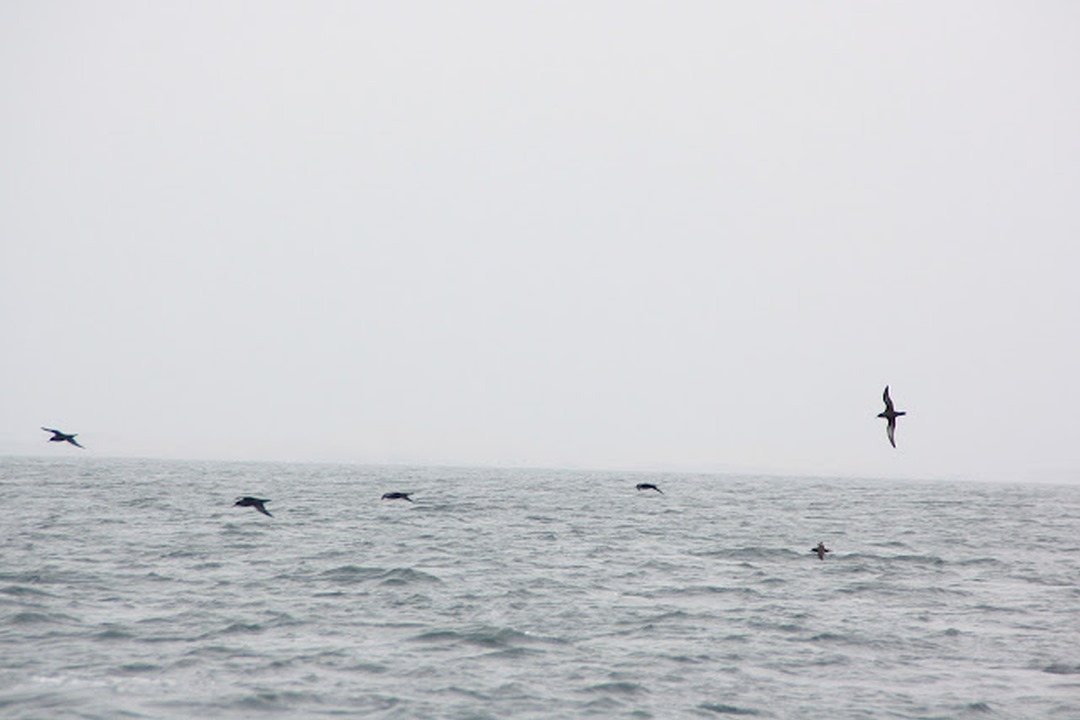On October 13 and 14, 2023, the Benin Fisheries and Ocean Research Institute (IRHOB) organized two sea trips for members of the GMES & Africa Students club. The primary objective was to introduce people to whales, but also to raise awareness about the preservation of the marine environment.
Whales observed off the coast of Cotonou. Photo: IRHOB (authorized use)
On October 13, 2023, off the Beninese continental shelf, the Benin Fisheries and Ocean Research Institute (IRHOB) orchestrated a truly exceptional maritime expedition for students. This initiative is a continuation of IRHOB’s previous efforts aimed at offering unique experiences to its students.
Nevertheless, this expedition stands out for its singularity, offering participants a breathtaking spectacle: the chance to observe whales, these majestic cetaceans which choose to descend into the Gulf of Guinea between mid-July and November to give birth. “This outing allowed us to observe a group of six whales, including 3 calves, a group of two whales (a mother and a calf), a group of 2 whales, and a group of 8 dolphins”confides Professor Zacharie Sohou, Director of IRHOB for whom “ This is a favorable time, as these species have a clear preference for warm waters when it comes to giving birth to their offspring.
Me, producing a broadcast during a sea trip with the IRHOB in 2020
Funding for this initiative comes from the European Union Community and the African Union Commission, through the program’s Marine and Coastal Area Management in North and West Africa (MarCNoWA) Project. GMES & Africa, headquartered at the University of Accra in Ghana. This valuable contribution underlines the importance of our mission. As the researcher in charge of this initiative points out, “The preservation of cetaceans and whales is of crucial importance for the balance of our oceans and marine biodiversity. Our goal is to raise awareness and educate the younger generation about their essential role in the balance of the oceans. »
Water serving bird life
These sea outings were not only an opportunity to admire the whales, they also coincided with the celebration of World Migratory Bird Days. This year, under the theme “Water for the life of birds”, the emphasis was placed on the crucial importance of water for these birds during the migration period. It also served as a reminder of the urgency of intensifying efforts to protect water resources, preserve aquatic ecosystems, and conserve living natural resources. Indeed, according to Professor Sohou, traditionally, hundreds of millions of birds spend the winter in Africa then return to Europe in the spring.
Currently, with increasingly mild winters and sufficiently abundant food resources, some people decide to no longer undertake a long migration, which is perilous. “We observed a group of around 100 to 200 individuals flying over the schools of fish, going up and down to look for their prey. Among white storks, for example, some no longer systematically make the journey south of the Sahara for the winter; perhaps because of storms and turbulence in the Mediterranean and wind turbines,” reveals the researcher.
For now, the decision to become sedentary or shorten its migration is unique to each bird. What governs this decision is not necessarily known, but we can hypothesize that physical condition at the time of departure plays a role.
A colony of birds seen during the outing. Photo: IRHOB (authorized use)
During this sea expedition, which brought together both students and staff from the Beninese Center for Scientific Research and Innovation (CBRSI) and the Research Institute for Development (IRD), particular attention has been carried to the study of other marine elements. More precisely, the researchers looked at the meeting point between the marine waters and those of the Cotonou channel, commonly called the mouth. They noted a shift in this transition zone towards the sea, resulting in a clear difference in color between the two types of water. This observation revealed crucial information about the dynamics of ocean currents and environmental phenomena in the region.
View of the participants of this sea trip. Photo: IRHOB (Authorized use)
